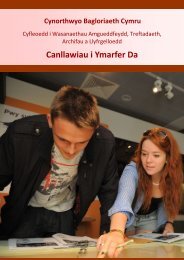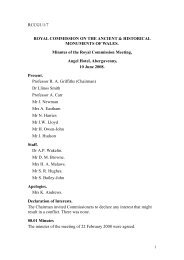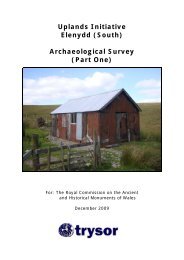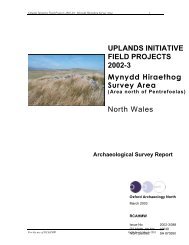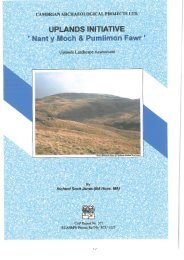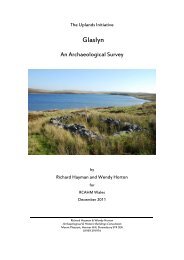Mynydd Llangynidr, Brecknockshire - Royal Commission on the ...
Mynydd Llangynidr, Brecknockshire - Royal Commission on the ...
Mynydd Llangynidr, Brecknockshire - Royal Commission on the ...
You also want an ePaper? Increase the reach of your titles
YUMPU automatically turns print PDFs into web optimized ePapers that Google loves.
<str<strong>on</strong>g>Mynydd</str<strong>on</strong>g> <str<strong>on</strong>g>Llangynidr</str<strong>on</strong>g> Upland Survey<br />
UIP081 Report Versi<strong>on</strong>: Final<br />
Produced for RCAHMW<br />
Upland deserted settlements, particularly those of potential medieval date with cognisance of<br />
surrounding agricultural or storage features associated with <strong>the</strong> domestic buildings<br />
6.8 A few upland deserted settlements or farmsteads were recorded during <strong>the</strong> project, for<br />
instance <strong>the</strong> ruins located in <strong>the</strong> valley below <str<strong>on</strong>g>Mynydd</str<strong>on</strong>g> <str<strong>on</strong>g>Llangynidr</str<strong>on</strong>g>. Often air photo evidence is <strong>the</strong><br />
first indicator of potential remains and usually identifies elements of <strong>the</strong> associated field system.<br />
O<strong>the</strong>rwise, <strong>the</strong>se sites are discovered during systematic field visits to sheepfolds, where attenti<strong>on</strong><br />
needs to be paid to incorporated remains of earlier structures.<br />
The structure, comp<strong>on</strong>ents and phasing of field systems in upland areas with an eye to<br />
possible early dating of some enclosures, and <strong>the</strong> presence of encroachment<br />
6.9 There were many former boundary walls discovered which had collapsed into banks. They<br />
were located <strong>on</strong> <strong>the</strong> north facing slopes of <str<strong>on</strong>g>Mynydd</str<strong>on</strong>g> <str<strong>on</strong>g>Llangynidr</str<strong>on</strong>g> and al<strong>on</strong>g <strong>the</strong> top of Carn Caws<br />
and Clo Cadno but were often very heavily obscured by vegetati<strong>on</strong> or wea<strong>the</strong>r c<strong>on</strong>diti<strong>on</strong>s. They<br />
are probably medieval or post-medieval. Early mapping can assist with dating post-medieval field<br />
systems but has been found to be of little use for earlier features. Associating field systems with<br />
date-specific structures and transport routes may be <strong>the</strong> <strong>on</strong>ly practical method of dating <strong>the</strong>m.<br />
Post medieval<br />
6.10 There are 316 (plus a possible fur<strong>the</strong>r twelve) records for <strong>the</strong> post medieval period,<br />
comprising almost half <strong>the</strong> records for <strong>the</strong> project. The period witnessed a dramatic increase in<br />
activity in <strong>the</strong> mountains as people of new skills and tools found gainful employment <strong>on</strong> <strong>the</strong><br />
slopes. There were still <strong>the</strong> shepherds with <strong>the</strong>ir huts, folds and dips, but <strong>the</strong> industrial revoluti<strong>on</strong><br />
signalled an improvement in quarrying techniques. Recreati<strong>on</strong>al shooting of course became<br />
widespread in upland areas during <strong>the</strong> 1800s.<br />
6.11 Most of <strong>the</strong> recorded sites were quarries and lime kilns, associated with spoil heaps and<br />
some buildings. The majority of <strong>the</strong> limekilns were surface kilns, heavily overgrown with waste<br />
heaps of burnt lime and charcoal material. There were some examples of well built st<strong>on</strong>e pot<br />
kilns, some freestanding mounds, o<strong>the</strong>rs dug into steep slopes. The loose waste material also<br />
inadvertently provided a material for walkers to c<strong>on</strong>struct recreati<strong>on</strong>al cairns out of.<br />
6.12 The shooting butts varied in form between single rubble walls, to crescent shaped circles,<br />
sometimes built out of older cairns.<br />
6.13 Very frequently observed sites in <strong>the</strong> survey area were hollows c<strong>on</strong>structed in <strong>the</strong> scree<br />
slopes. It was clear that while most were roughly built holes probably associated with modern<br />
military training, some were of far better c<strong>on</strong>structi<strong>on</strong> and had far superior views of <strong>the</strong> open<br />
mountainside. The latter were recorded as post medieval shooting butts, though of course, even<br />
some of <strong>the</strong> freestanding butts could be modern in date.<br />
The presence and extent of remains of rural industries in <strong>the</strong> uplands, particularly peat<br />
cutting, quarrying, rabbit farming and mining<br />
6.14 Quarrying for limest<strong>on</strong>e to produce lime is <strong>the</strong> main industry present in <strong>the</strong> survey area and<br />
was found throughout, though <strong>the</strong> extent of each quarry varied widely. O<strong>the</strong>r quarries were found<br />
to extract walling st<strong>on</strong>e or o<strong>the</strong>r building materials in <strong>the</strong> later periods. There were a number of<br />
modern disused quarries in <strong>the</strong> area surveyed, with partially tarmaced roads and access routes<br />
that had been recently blocked off. Evidence of extensive quarrying was found al<strong>on</strong>g outcrops,<br />
such as above <strong>the</strong> area of forestry between SO 14300, 16400 and 14800, 16900, with frequent<br />
scalloping of <strong>the</strong> hillside. The topography sometimes made it difficult to distinguish between<br />
natural scree and specific areas of industrial quarrying. There were numerous small scoops in <strong>the</strong><br />
slopes of most of <strong>the</strong> peaks and close to st<strong>on</strong>e wall boundaries such as at SO 16468 13732 where<br />
st<strong>on</strong>e for <strong>the</strong> wall was quarried <strong>on</strong>-site.<br />
Page 15<br />
\\Harappa\projects\UIP081 <str<strong>on</strong>g>Mynydd</str<strong>on</strong>g> <str<strong>on</strong>g>Llangynidr</str<strong>on</strong>g>\Reporting\Draft Final\AP UIP081 <str<strong>on</strong>g>Mynydd</str<strong>on</strong>g> <str<strong>on</strong>g>Llangynidr</str<strong>on</strong>g> report<br />
(Draft Final).doc<br />
Copyright ArchaeoPhysica Ltd. 10/02/2009




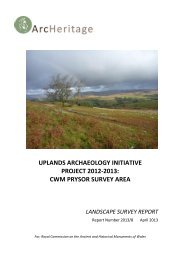
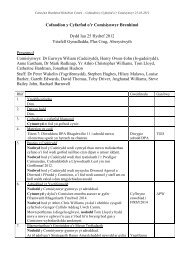
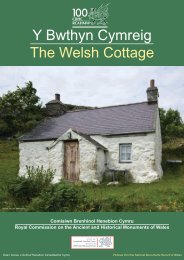

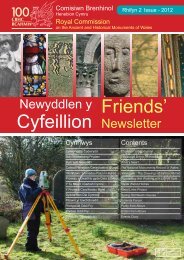
![The Source of the Usk Walk [2012 PDF]](https://img.yumpu.com/49285699/1/190x245/the-source-of-the-usk-walk-2012-pdf.jpg?quality=85)

